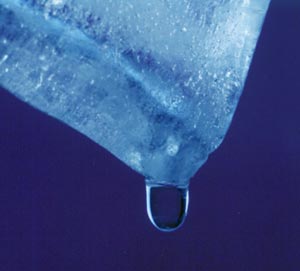Phase Transformation Temperatures
 When temperature rises and pressure is held constant, a typical substance changes from solid to liquid and then to vapor. Transitions from solid to liquid, from liquid to vapor, from vapor to solid and visa versa are called phase transformations or transitions. Since some substances have several crystal forms, technically there can also be solid to another solid form phase transformation.
When temperature rises and pressure is held constant, a typical substance changes from solid to liquid and then to vapor. Transitions from solid to liquid, from liquid to vapor, from vapor to solid and visa versa are called phase transformations or transitions. Since some substances have several crystal forms, technically there can also be solid to another solid form phase transformation.
Phase transitions from solid to liquid, and from liquid to vapor absorb heat. The phase transition temperature where a solid changes to a liquid is called the melting point. The temperature at which the vapor pressure of a liquid equals 1 atm (101.3 kPa) is called the boiling point. Some materials, such as many polymers, do not go simply from a solid to a liquid with increasing temperature. Instead, at some temperature below the melting point, they start to lose their crystalline structure but the molecules remain linked in chains, which results in a soft and pliable material. The temperature at which a solid, glassy material begins to soften and flow is called the glass transition temperature.